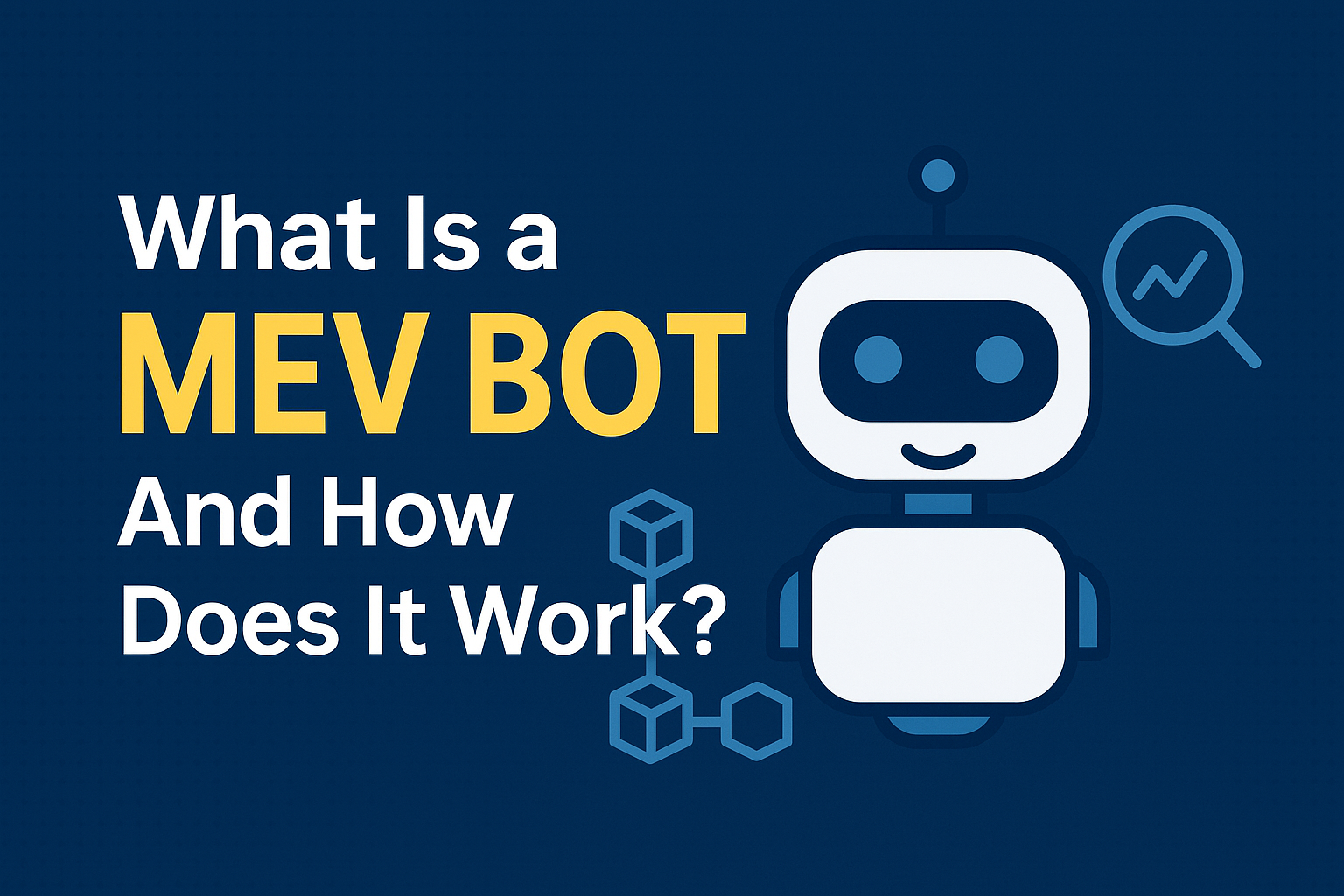- MEV Basics — Why MEV Exists
- How a MEV Bot Operates (Technical & On-Chain Flow)
- Mempool Monitoring & Opportunity Detection
- Strategy Execution & Transaction Placement
- Common MEV Strategies
- On-Chain Tracing & Profit Attribution
- Benefits, Drawbacks & Real-World Impact
- Why & How MEV Bots Matter — A Cause → Effect View
- Technical Implementation (High-Level)
- Mitigations & Future Directions
- Summary & Conclusion

A MEV bot is an automated algorithm that exploits transaction ordering opportunities in blockchain systems. In this article, we dive into MEV bot mechanics, strategies, risks, and both technical and on-chain analysis. We’ll explain why they arise and how they affect ordinary users and the DeFi ecosystem.
MEV Basics — Why MEV Exists
What Does “MEV” Mean?
MEV stands for Maximal Extractable Value (formerly “Miner Extractable Value”). It refers to the additional profit that can be extracted by reordering, including, or excluding transactions within a block—beyond standard block rewards and gas fees.
In proof-of-stake systems (like Ethereum post-merge), validators (and “searchers”) now have the ability to influence transaction order, broadening who can extract MEV.
Why MEV Is a Thing
- Transaction ordering flexibility: Block builders or validators decide which pending transactions go in what sequence.
- Mempool visibility: Before transactions are included, they reside in a public mempool; bots can watch and react.
- DeFi and smart contracts: The complexity of decentralized finance (swaps, liquidity pools, lending) creates arbitrage, liquidation, and incentive opportunities.
- Gas bidding competition: Bots can outbid other transactions by offering higher gas (priority fee) to get favorable placement.
How a MEV Bot Operates (Technical & On-Chain Flow)
Mempool Monitoring & Opportunity Detection
A MEV bot constantly scans pending transaction pools across nodes. It identifies candidate trades (large swaps, impending liquidations, price deviations) that could be profitable.
It often simulates the effect of executing a potential transaction against the current pending state to check profit margins.
Strategy Execution & Transaction Placement
Once an opportunity is validated, the bot crafts one or more transactions and submits them with carefully calculated gas fees to ensure they land in a beneficial spot in the block (before, after, or between other transactions).
Some bots bypass the public mempool and send bundles to block builders or “relays” (e.g. Flashbots) to avoid front-running by others. Debut Infotech+3blocknative.com+3tastycrypto+3
Common MEV Strategies
Here are the core strategies used by MEV bots:
| Strategy | Description | Use Case & Risk |
|---|---|---|
| Arbitrage | Exploit price differences for the same token across different DEXs or markets | Low-risk, high-frequency; intense competition |
| Sandwich Attack | Place a transaction before and after a target trade to profit from slippage | Often viewed as predatory to ordinary users |
| Front-running / Back-running | Submit a transaction just before (front-run) or just after (back-run) a large pending trade | Timing sensitive, gas wars |
| Liquidation Sniping | Spot undercollateralized loans and submit the liquidation transaction | Very competitive environment |
| Flash Loan Based Strategies | Borrow a large amount without collateral (temporarily) to boost arbitrage power | Complex, requires smart contracts |
| Cross-chain MEV / Bridge Exploits | Take advantage of price or liquidity imbalances across chains | Emerging, high-risk domain |
On-Chain Tracing & Profit Attribution
Once a MEV strategy is executed, on-chain analytics trace flows of tokens and ETH back to profit-taking addresses. Many MEV bots rotate contracts but consolidate profits to the same address, making detection possible.
Recent academic work shows that in Ethereum between August 2023 and March 2025, ~US$233.8 million was extracted via CEX-DEX arbitrage by a handful of top searchers.
On layer-2 blockchains, MEV is still prevalent, though the dynamics differ (less public mempool, lower fees) — yet nontrivial MEV extraction still occurs.
Also, block builder auctions (MEV-Boost) are highly concentrated — just a few builders produce the majority of blocks.
Finally, quantification of MEV on Layer 2s shows billions in potential value (e.g. $213 million+ on Polygon) from arbitrage alone.
Benefits, Drawbacks & Real-World Impact
Pros (Potential Benefits)
- Market efficiency / price alignment: Arbitrage MEV helps reduce sniping price discrepancies across DEXs.
- Protocol health via liquidations: Bots help liquidate bad debt in lending platforms, preserving protocol stability.
- Revenue to validators / block producers: MEV tips incentivize block builders.
- Innovation & competition: The presence of MEV encourages upgrades to fairness mechanisms and privacy features.
Cons (Risks & Harms)
- Unfairness to ordinary users: Bots with faster access and capital extract value from regular traders (sandwich, frontrunning).
- Elevated gas costs: Competitive bidding by MEV bots drives up fees for everyone.
- Centralization pressures: Dominance of a few searcher-builder alliances may weaken decentralization.
- Volatility amplification: Aggressive MEV actions can worsen price swings or flash crashes.
- Ethical ambiguity: Is sandwiching or frontrunning “legitimate trading,” or exploitation?
Cases & Data
- On the Base chain, two entities are responsible for over 80% of spam gas usage in their MEV operations.
- Cross-chain bridge exploits are a rich frontier: during bridge failures, MEV actors swarm to extract value from chaos.
- In CEX-DEX arbitrage on Ethereum, three searchers captured ~75% of extracted value between 2023–2025.
Why & How MEV Bots Matter — A Cause → Effect View
- Cause: Transparency of the mempool + decentralized ordering freedom.
→ Effect: Bots can monitor and react to pending trades. - Cause: DeFi protocols with arbitrage, lending, swap spreads.
→ Effect: Profit opportunities emerge for bots. - Cause: Competition for block space & fee bidding wars.
→ Effect: MEV bot submits higher fees to outcompete others. - Cause: Concentration of block builder power and searcher alliances.
→ Effect: Reduced competition and more predictable dominance by top players. - Cause: Bot dominance and high gas cost.
→ Effect: Poor user experience (higher costs, front-run risk), pushing developers to build MEV-resistant protocols or private mempools.
Technical Implementation (High-Level)
Here is a simplified stack or flow of components a real MEV bot might incorporate:
- Node / RPC access: Full node or archival node + mempool subscription
- Mempool watcher: Real-time monitoring of pending transactions
- Opportunity engine / simulator: Simulate trades and estimate profitability
- Gas pricing module: Dynamically choose priority fees
- Bundle builder / relay interface: Send transactions or bundles to block builders or relays
- Smart contract logic: For flash loans, aggregation, callbacks
- Profit collector / address management
- Monitoring & analytics: On-chain tracing, performance metrics, fallback logic
If any part fails (bad gas estimation, network latency, front-run by another bot), the transaction may fail or yield a net loss.
Mitigations & Future Directions
Protocol-Level Solutions
- Private or encrypted mempools: Hide pending transactions until block submission.
- Fair ordering protocols: Algorithms that randomize or neutralize transaction order advantages.
- MEV auctions: Let searchers bid transparently for ordering rights.
- Batching & time windows: Force transactions to batch by time slots rather than free ordering.
Research & On-Chain Innovations
- Academic studies (e.g. rollups) show that MEV can be more limited but still present in Layer 2 chains.
- Quantitative research (CEX-DEX arbitrage) shows that exclusivity between searchers and builders amplifies centralization.
Summary & Conclusion
In summary, a MEV bot is an automated system that extracts Maximal Extractable Value by monitoring the mempool, simulating profitable trades, and positioning its transactions to capture value. These bots employ strategies such as arbitrage, sandwiching, liquidation sniping, and flash loan execution.
While MEV bots contribute to market efficiency and protocol health in some respects, they also introduce risks such as elevated gas fees, fairness issues, and centralization. On-chain analytics and academic studies show that MEV is concentrated among a few major players, especially in CEX-DEX arbitrage extraction.
The blockchain ecosystem is actively seeking mitigations—private mempools, fair ordering protocols, batching, and new architecture—to balance innovation and fairness.
Not financial advi





